#CrossBorderRail is a very political project – to push for better international railway connections between European countries. But one of the things that makes the project so fun is that it has taken me to some wonderful places amongst the 130 borders I have crossed in the past 12 months (and a few before then as well).
So here is a completely non-political list of some cross border rail lines you should visit – because they are in wonderful places, or the trains are a joy to take. Note this is not a list of good quality rail services! This post is also not a ranking – number 1 is not better than number 10. And there are no doubt wonderful lines I have not yet discovered. But I hope this list coveys some of the joy and fascination this project inspires.
1. Bayerisch Eisenstein
Border: Germany to Czechia
Location: between Plattling (DE) and Plzeň (CZ) – on OpenRailwayMap and Google Maps
Active railway: Yes, both sides of the border
How to get there: Waldbahn from Plattling, or ČD trains from Klatovy
Accessible on Interrail: Yes, and also Deutschlandticket from German side
Flickr album from the last time I took the route – #CrossBorderRail 2022 Day 26
Why you should go there: the DE-CZ border bisects the station building (note the different colours of the roof!) and there is a little museum about when this was a border on the Iron Curtain. The Waldbahn to get there runs like clockwork, and the route from Plattling passes through perfect Bavarian countryside. There are lots of excellent walking and cycling routes from the station, and a decent beer garden next to the station. This is never going to be a major border crossing, but it is a charming spot and is a super place to visit for a day trip!
2. Canfranc
Border: France to Spain
Location: between Pau (FR) and Zaragoza (ES) – on OpenRailwayMap and Google Maps
Active railway: No, only Spanish side – but a bus can get you to Bedous (nearest active railway in France)
How to get there: SNCF TER Pau-Bedous, or Renfe Zaragoza-Huesca-Canfranc, bus between Canfranc and Bedous – but just be aware there are some engineering works Spanish side at the moment
Accessible on Interrail: Yes, even valid in the bus
Flickr album from the last time I took the route – #CrossBorderRail 2022 Day 16
Why you should go there: Canfranc station – now turned into a hotel – is one of the most extraordinary border stations you will ever see. The actual railway station has been shifted into the former goods hall (green roof, pictured). The problem is that despite the grandeur trains have not passed here since the 1970s, because a runaway train destroyed a bridge on the French side. Discussions are ongoing to re-open the whole line, but it is going to be some years before this happens. In the meantime enjoy the Pyrénées scenery from the trains and buses to make the connection between Pau and Zaragoza. The trip takes best part of a day, but you will not regret it for the scenery.
3. Tirano – St Moritz
Border: Italy to Switzerland
Location: north east of Milano, south east of Zürich – border on OpenRailwayMap and Google Maps
Active railway: Yes, both sides. Standard gauge line to Tirano from the rest of Italy, to Chur from the rest of Switzerland – and narrow gauge between Tirano and Chur via St Moritz
How to get there: Trenord regional train Milano Centrale – Tirano, or SBB train Zürich – Chur, then Rhätische Bahn Chur – St Moritz
Accessible on Interrail: Yes, although a supplement is necessary for the panorama carriage on the route – but the regular regional train (no supplement) is better as you can open the windows
Flickr album from the last time I took the route – May 2023, #CrossBorderRail Extra Day
Why you should go there: Two parts of the Rhätische Bahn – the Bernina Line (Tirano – St Moritz) and the Albula Line (St Moritz – Thusis) – are listed by UNESCO as world heritage sites. Tirano is in Italy, St Moritz in Switzerland. The Bernina Line climbs to 2253m above sea level, passes lakes and glaciers, and is an extraordinary feat of engineering. You spent the whole trip glued to the window. And as if that were not enough, making the trip is even reasonably priced – take a normal train on the route and there is no supplement on Interrail, and for passengers from Germany you can even get the whole way to Tirano from Germany on a Deutsche Bahn Sparpreis ticket. You need the best part of a day to do the trip justice, but it is something you should see once in your life – although the train is often filled with tourists doing just that!
4. Bar – Belgrade
Border: Montenegro to Serbia, and it also crosses a few kilometres of Bosnia – but does not stop there
Location: it runs the length of Montenegro, and crosses most of southern Serbia – border on OpenRailwayMap and Google Maps
Active railway: Yes, both sides
How to get there: Complicated. A ferry across the Adriatic to Bar, or a bus from Dubrovnik to Bar. Getting to Belgrade by train is complicated currently due to engineering works on much of the Serbian network
Accessible on Interrail: Yes, although a supplement is necessary for a seat reservation or berth in the night train
Why you should go there: The Tito-era line to link Montenegro to the rest of the Yugoslavian rail network is an extraordinary feat of engineering – it rises and rises as you leave the Montenegro capital Podgorica, and crosses dozens of bridges and passes dozens of tunnels as it climbs. The scenery is stunning, and it is best to do all of the southern part of the route in the daytime (a daytime train runs only in the summertime, a night train runs all year – if you have to take that then best start in Belgrade – so you get the scenic parts in the morning light). The train with its hulking Romanian built locomotive, and rather worn carriages, is not the best – but the whole thing is a wonderful experience. And you can get the wind in your hair through the open windows of the dining car on the daytime train.
5. Cheb – Adorf (Vogtland)
Border: Czechia to Germany
Location: at the north western corner of Czechia, north of Cheb (CZ) and south of Plauen (DE) – border on OpenRailwayMap and Google Maps
Active railway: Yes, both sides
How to get there: Start your trip in either Cheb or Plauen – both of which are well connected with their respective national networks
Accessible on Interrail: Yes, no supplements. Deutschlandticket also valid Plauen – Bad Brambach
Flickr album from the last time I took the route – August 2022, #CrossBorderRail Extra Day
Why you should go there: Cross the DE-CZ border 6 times in 30 minutes as the train winds its way through the hills in the border region, through forests and past small villages. It might only be a railbus, but it is also a decent and comfortable train. Vojtanov on the Czech side is also full of slightly old fashioned rail charm, and Cheb is a historic city well worth a visit. Not the fastest way to get across this border, but definitely one of the most interesting!
6. Zagreb – Ljubljana
Border: Croatia to Slovenia
Location: eastern Slovenia, north eastern Croatia – border on OpenRailwayMap and Google Maps
Active railway: Yes, both sides
How to get there: The mainline between the two capitals – Ljubljana is well connected to Austria. The route from Wien and Graz via Maribor to Zagreb also uses most of the same route
Accessible on Interrail: Yes, although supplements for seat reservations are needed for some trains
Flickr album from the last time I took the route – October 2022, #CrossBorderRail Extra Day
Why you should go there: Two wonderful cities – Ljubljana and Zagreb – are connected by a comparatively slow but very scenic main line that follows the Sava river. On the Zagreb end of the line the river is wide and slow, due to barrages. Closer to Ljubljana, along the gorge from Zidani Most it is narrower and wilder. Sit on the left when departing Zagreb, or the right when departing Ljubljana for the best views. The route is also taken by night trains from Zagreb to Zürich and München. Croatia also joined Schengen in 2023, so border procedures at Dobova – the border station – are also easier than they were. Zagreb Glavni kolodvor – the main station – has seen better days but has a old world charm to it.
7. Haparanda – Tornio
Border: Sweden to Finland
Location: at the top of the Baltic Sea – border on OpenRailwayMap and Google Maps
Active railway: Swedish trains as far as Haparanda, Finnish trains as far as Tornio-Itäinen – 4km in between
How to get there: In Sweden a night train to Boden, then local train to Haparanda. In Finland a night train to Tornio-Itäinen
Accessible on Interrail: Yes, although supplements are needed for night trains
Flickr album from the last time I took the route – #CrossBorderRail 2022 Day 6
Why you should go there: Tornio and Haparanda, and how they merge together – in two different time zones – is interesting in itself. As a pedestrian it is not obvious where the border even is. The border bridge – shown – is majestic, and in Tornio old station there is a plaque to mark that Lenin once passed here. On the Finnish side, despite the basic nature of the station, the night train to Helsinki is one of the best overnight services anywhere in Europe. At Tornio-Haparanda you feel like you are a long way from everything, but that’s what makes it special. Passenger trains should cross the border bridge once more from 2024, but for now it is a walk, an irregular bus, or a taxi to get to the other side.
8. Zawidów – Černousy
Border: Poland to Czechia
Location: in the south western corner of Poland, and north of Liberec (CZ), also not too far from Germany (Görlitz) – border on OpenRailwayMap and Google Maps
Active railway: only on the Czech side
How to get there: hourly trains from Liberec to Černousy – Zawidów station is a short hike or bike ride from Černousy
Accessible on Interrail: Yes
Flickr album from the last time I took the route – August 2022, #CrossBorderRail Extra Day
Why you should go there: The hulking border station at Zawidów feels like something stuck in time. The steps are ramshackle, the waiting room needs a lick of paint, and grass and bushes are growing all around. The track is still in use by the occasional freight train. If you follow the lane to Černousy it runs right next to the track at the border, and you can see where the wooden Polish sleepers change for the more modern concrete ones on the Czech side. Černousy station by contrast is tiny and sweet, as a little but impeccable railbus pulls up in front of the small building with apple trees lining the field opposite. Everything feels a little forgotten, but it is a charming little route for a day trip.
9. Portbou – Cerbère
Border: Spain to France
Location: at the Mediterranean coast, north of Barcelona and south of Perpignan – border on OpenRailwayMap and Google Maps
Active railway: active both sides, but change of trains at either Portbou or Cerbère necessary
How to get there: TER trains from Perpignan, or Rodalies from Barcelona – just be aware not all trains Spanish side show in international travel planners, so consult the Rodalies site
Accessible on Interrail: Yes
Flickr albums from the last time I took the route – #CrossBorderRail 2022 Day 20 and #CrossBorderRail 2022 Day 21
Why you should go there: The old line along the Mediterranean coast is much more interesting than the newer high speed line further inland. It connects Barcelona with Girona and Figueres (with its Dalí museum) to Perpignan and onwards into Languedoc. The scale of the infrastructure at the border is testimony to the importance of this connection in times past, with the old goods yards and large border stations still present. In both Portbou (Spanish side) and Cerbère (French side) you can take a dip in the sea while waiting for your connecting train, or hike up the hill in between for majestic views. And the sun rising over the sea when taking an early morning train on either side of the border is wonderful.
10. Görlitz – Zgorzelec
Border: Germany to Poland
Location: south east of Berlin – close to the three country corner DE-PL-CZ – border on OpenRailwayMap and Google Maps
Active railway: active both sides, but change of trains at either Görlitz or Zgorzelec necessary
How to get there: regional trains from Berlin (via Cottbus) or Dresden, or regional trains from Wrocław
Accessible on Interrail: Yes. Deutschlandticket also works – because the shuttle train across the bridge between Görlitz and Zgorzelec is free
Flickr album with the pictures from my various trips here
Why you should go there: Not only is this a cross border rail absurdity, with the electrification masts for the line ending in the middle of the bridge, but Görlitz is a wonderful, historical and scenic place – it is no surprise it is used as the set for so many films once you see how well preserved it is. The Neiße river is the border here, and there are pleasant paths to walk along it. Zgorzelec on the Polish side feels more gritty but also more lively than Görlitz.

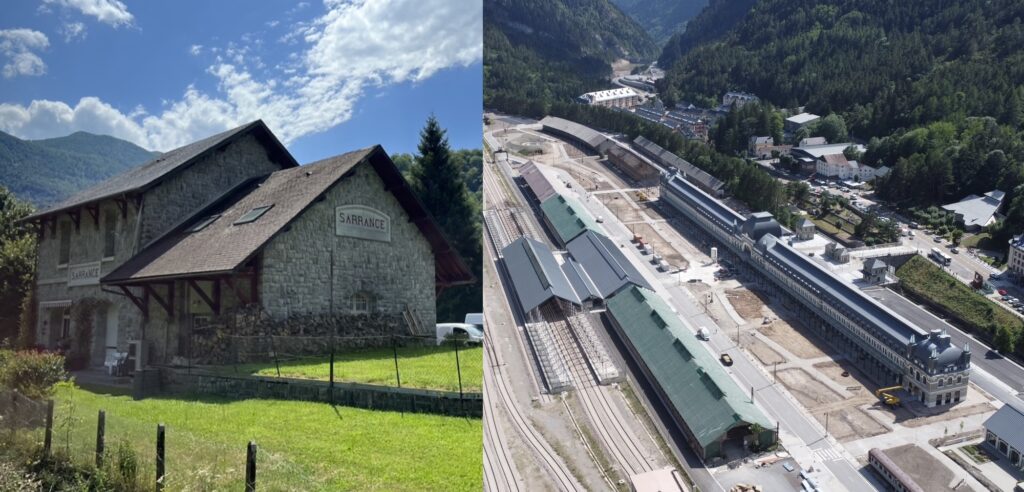
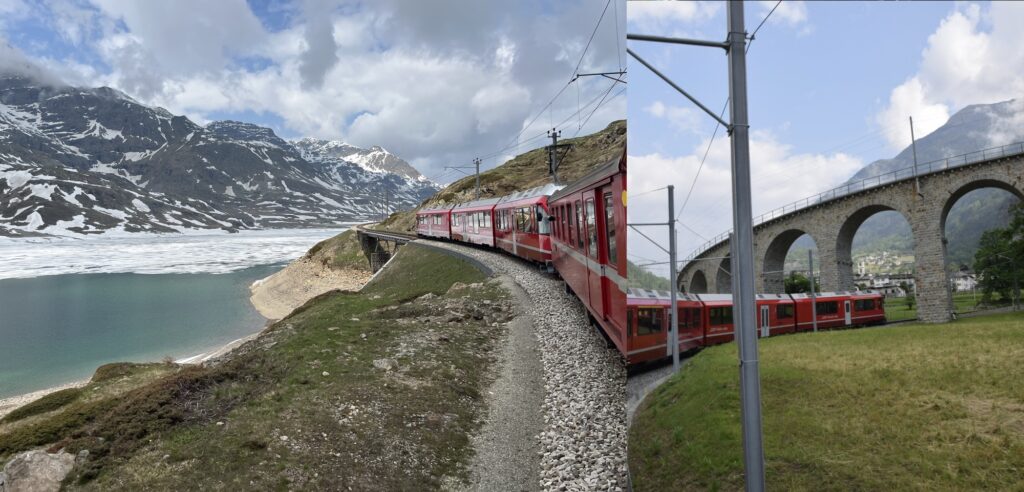


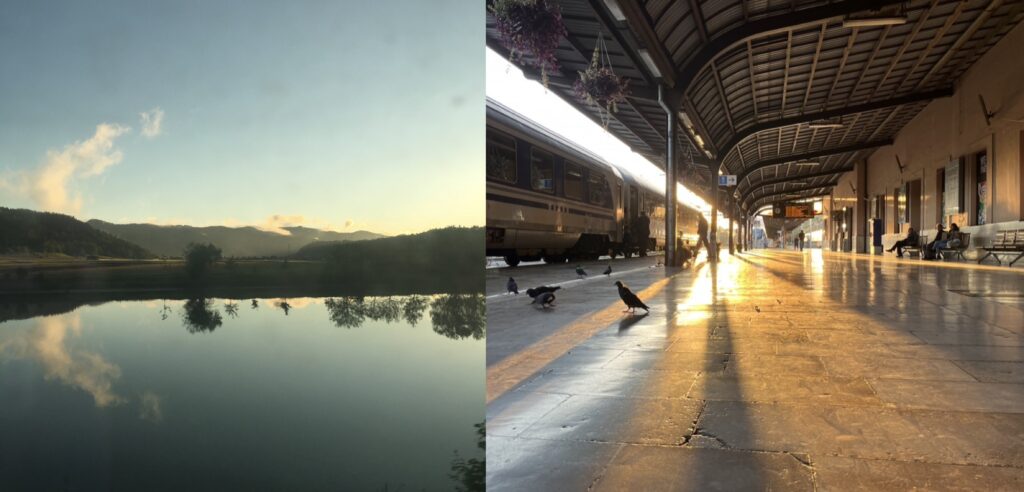
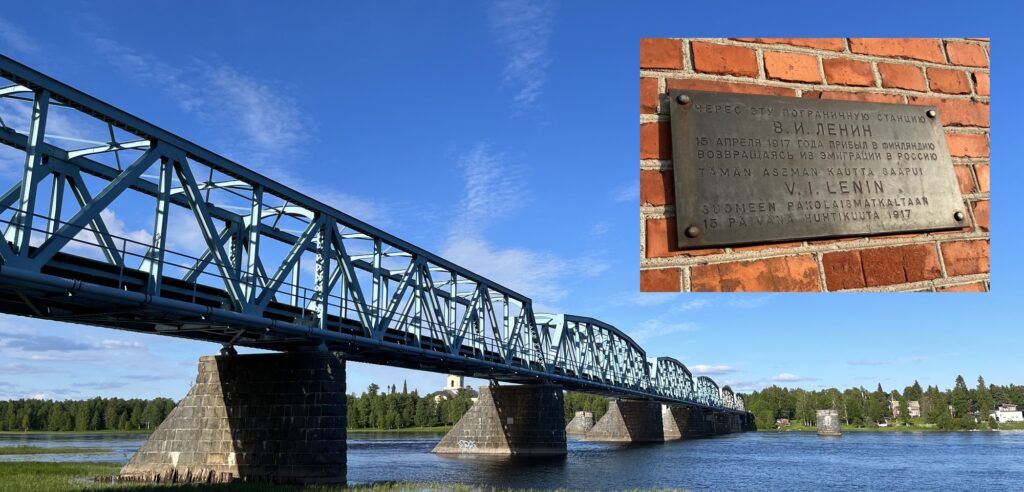
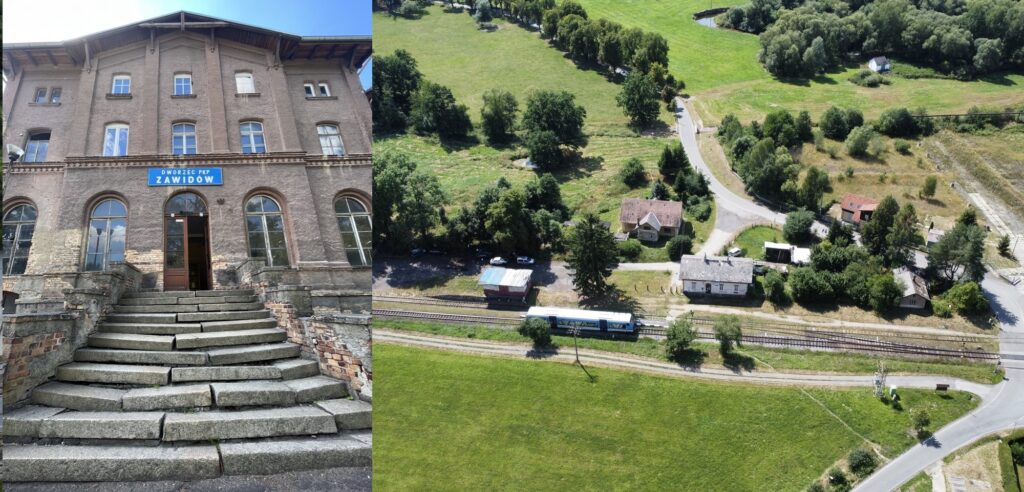
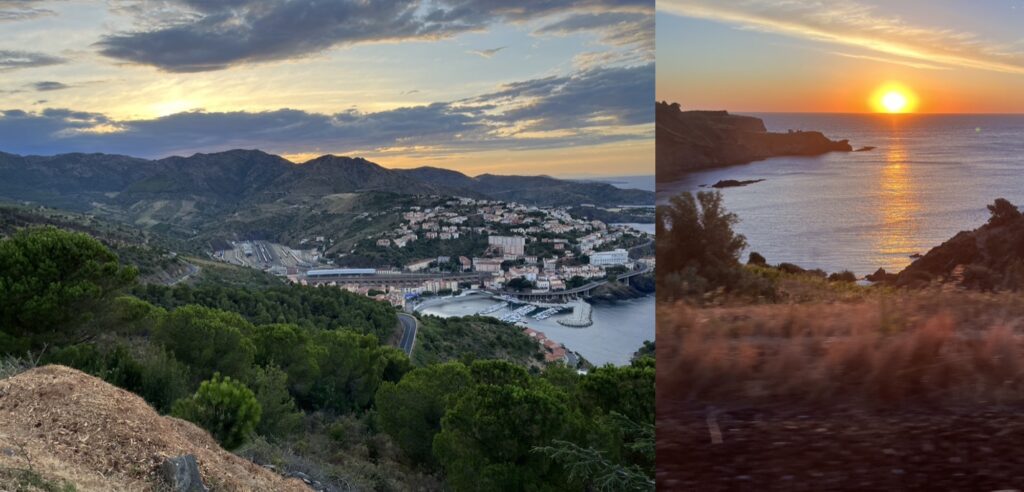


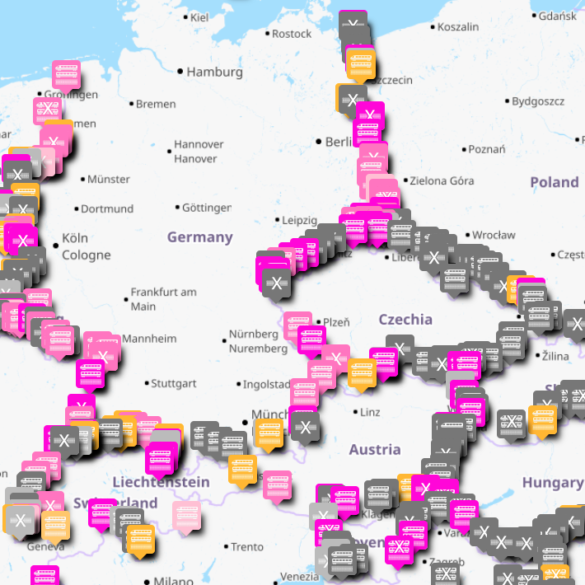

Excellent information Jon. Thanks.
P.S. The railway line to Canfranc has recently been closed. It will take the best part of one year for the combination of broad and standard gauge tracks to be laid. The standard gauge tracks will allow AVE trains and eventually connect to the French network.
Hi Barry – I wish you were right, but sadly it’s not proceeding that swiftly to Canfranc! The minimal works concluded last autumn and the line is open again this summer. The plan is to slowly put down the dual gauge sleepers. And there’ll never be a AVE or anything high speed on the line – it’s too winding.
Hi Jon,
I’ve just been Tirana-Podgorica-Belgrade-Zagreb. Sadly, half of that was buses 🙁
Any idea when the Belgrade-Zagreb route will be reopening? Would be much nicer by train…
Tirana – Podgorica has never had passenger trains. There’s been talk for the past 2 years to re-open Zagreb – Beograd but there’s nothing concrete. Podgorica – Beograd should still work though, at least with a night train!